Throngs of vendors fill the narrow alleys outside the royal courtyard. Colorful shirts for souvenir and appetizing scent of bakso – meatball soup – keep bargain hunters and tourists stay in this maze-like seasonal market for hours, among other things. It takes a while for us to find the entrance to the Keraton – the Royal Palace – as we have to navigate through the tarpaulin-covered narrow walkways while spotting a modest Ferris wheel at an open space. It is merely one week before the celebration of the birth of the Prophet Muhammad, often carried out in festivities across the country.
It is not an easy thing to locate the entrance gate. But fortunately the typical hot and humid air of coastal cities in tropical regions is absent this time, sparing all of us from excessive sweating. As I have anticipated, the gate to the inner courtyard looks rather modest for a palace’s standard. An old man sits near the ticket counter, waiting for a group of tourists to come, us. Wearing a green shirt with tiny holes on some parts – probably burned by his own cigarettes – and a pale Batik cloth around his legs, he turns out to be the official tour guide to the royal palace complex.
This is the Keraton Kasepuhan of Cirebon, the seat of the once reputable sultanate on the northern coast of Java with thriving trade and cultural cooperation with regions as far as China, India, and the Middle East. The sultanate reached its peak in the 16th century when it flourished not only as an important trade port, but also a center for Islamic studies in Java.
Two white tiger statues stand in a symmetrical proportion on top of an artificial coral rag, welcoming everyone to the inner courtyard. Directly behind them stands the white-washed gate to the palace, adorned with mega mendung – literally cloudy skies – patterns on the lentil which are unique to Cirebon and might have been influenced by Chinese traditional patterns. We enter the Keraton from the right wing of the palace complex, through a narrow gateway embellished with small colorful porcelains from China. To our right, a surau – small praying hall – with an intricately carved wooden pillar and glossy black tiles sits in solitude, detached from the main palace building. A few steps forward, we find the entrance to the audience hall to our left.
As is the case with the entrance gate, the audience hall looks too humble for a palace – scarcely decorated with artistic ornaments which are ubiquitous in most royal palaces. However the most interesting part lies right behind the throne, a wall mounted by small ceramic plates depicting scenes from the Bible and the landmarks of the Netherlands.
The Dutch played an important role in the history of the Sultanate of Cirebon as they proposed the initiative to split the sultanate into two ruling families – part of the strategy to weaken local kingdoms throughout the archipelago. In the 17th century, the sultanate was divided between two main royal houses – the house of the elders (Kasepuhan) and the house of the youth (Kanoman) – each has its own palace. The former retains the seat of the sultanate in the Keraton, while the latter had to move to a new palace compound called Keraton Kanoman.
The audience hall is the furthest we can enter because the rest of the palace is still used and inhabited by the descendants of the Kasepuhan house, including the current sultan, Sultan Sepuh XIV. The royal family had long relinquished its right to rule Cirebon and ceded the governance of the city and surrounding regions to the civil government. However the sultan still plays a significant role as a cultural leader for the locals. He himself is a businessman in his everyday life.
Before we leave the Keraton, our mannered guide takes us to a small museum, a few walks away from the main palace building. It is the house of Kereta Singa Barong, the original royal chariot dating back to the 18th century. The wooden chariot is crested with a sculpture of Singa Barong – a mystical creature with the head and horns of a dragon, the trunk and tusks of an elephant, and a pair of wings. Each element represents the close relationship between the sultanate and other nation – the dragon for China, the elephant for India, and the wings for the Middle East. As a matter of fact, Princess Ong Tien – the daughter of Emperor Hong Gie of the Ming Dynasty – was married to Sunan Gunung Jati, the ruler of Cirebon in the late 15th century. He himself was born from an Egyptian father and a Sundanese mother.
Finding our way out of the Keraton proves a lot easier as we have already known the way. Having immersed in a hefty dose of history of the royal palace, we agree that a nice lunch is what we need and further exploration of the city will be a nice thing to do in our short visit.
Cirebon itself, along with many other regions in Indonesia, has its own Batik industries. One particular pattern which is unique to Cirebon is the mega mendung, similar with the patterns we found in the keraton. The curvy minimalistic patterns transform into vibrant colors of Batik clothes where shades of red, green, black, and orange mega mendung patterns are hand-drawn or printed onto. Like other cities in Indonesia, Dutch colonial buildings are abound in Cirebon. Quite close to Keraton, we spot a large and relatively well-maintained colonial building which seems to belong to the British American Tobacco (BAT).
Time is one thing we lack of on this visit to Cirebon. However we make sure to make the best out of it when it comes to food. Local delicacies such as empal gentong (sliced beef in rich beef broth with coconut milk, turmeric, chopped scallions, and other spices), nasi jamblang (white rice covered in teak leaf and served with various side dishes), and skewered young mutton are too good to miss. Spices-infused beef slices tickle our palates alternately with melt-in-your-mouth skewered mutton in chili and soy sauce, and the subtly fragrant nasi jamblang with spicy hard-boiled eggs gently pinch our taste buds. Soto daging sapi – sliced beef in light beef broth with sliced fried shallots, sliced tomatoes, spices, and a spoonful of sambal – although not necessarily native to Cirebon also tastes a lot better than what I usually have. I will seriously consider for coming back to this city even only for the food.

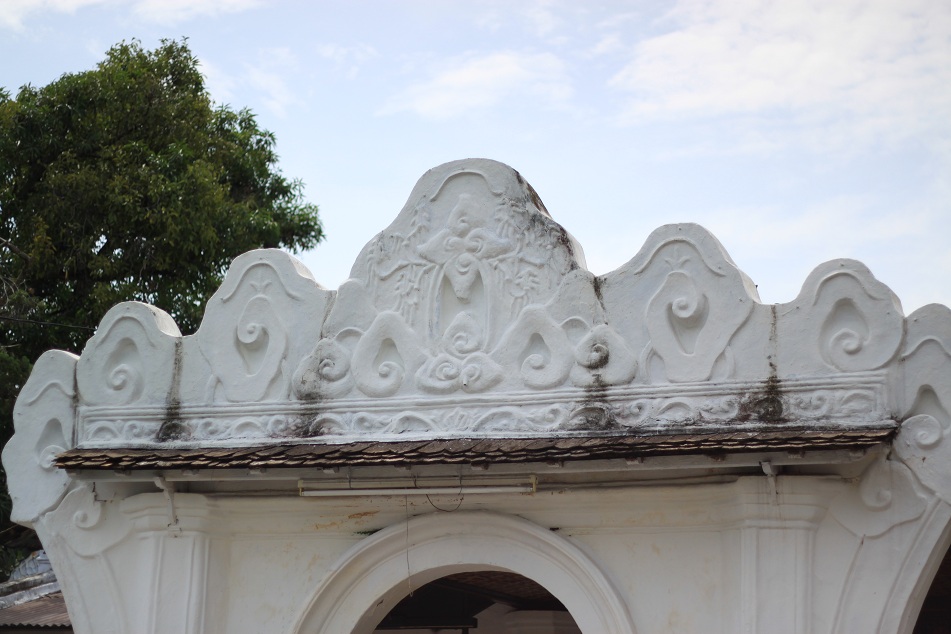
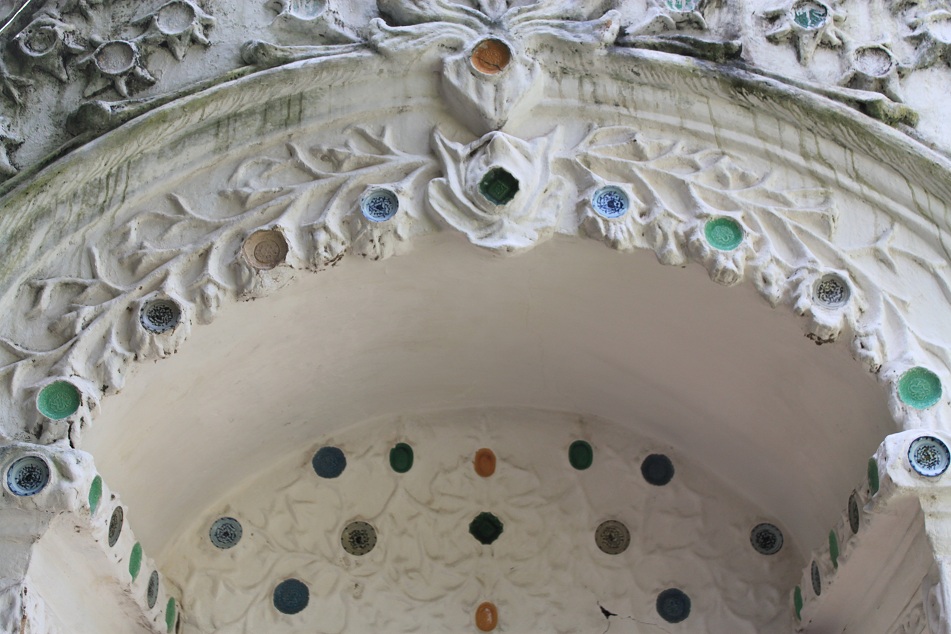
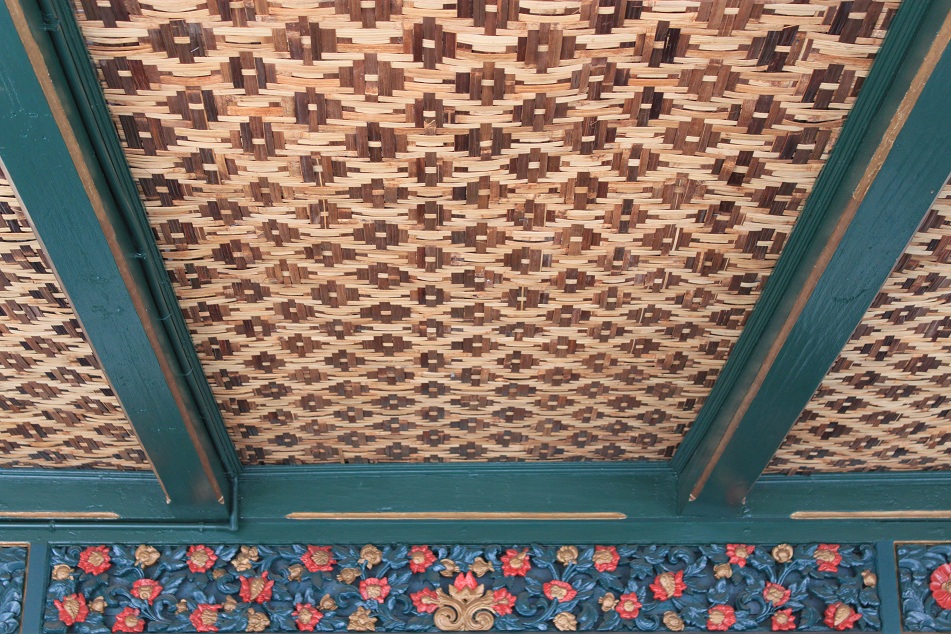
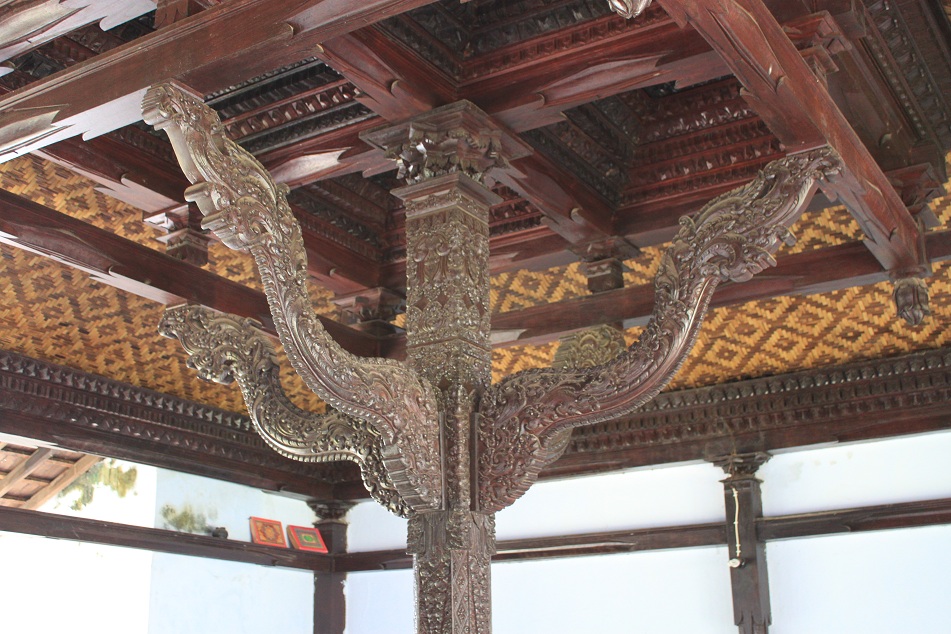
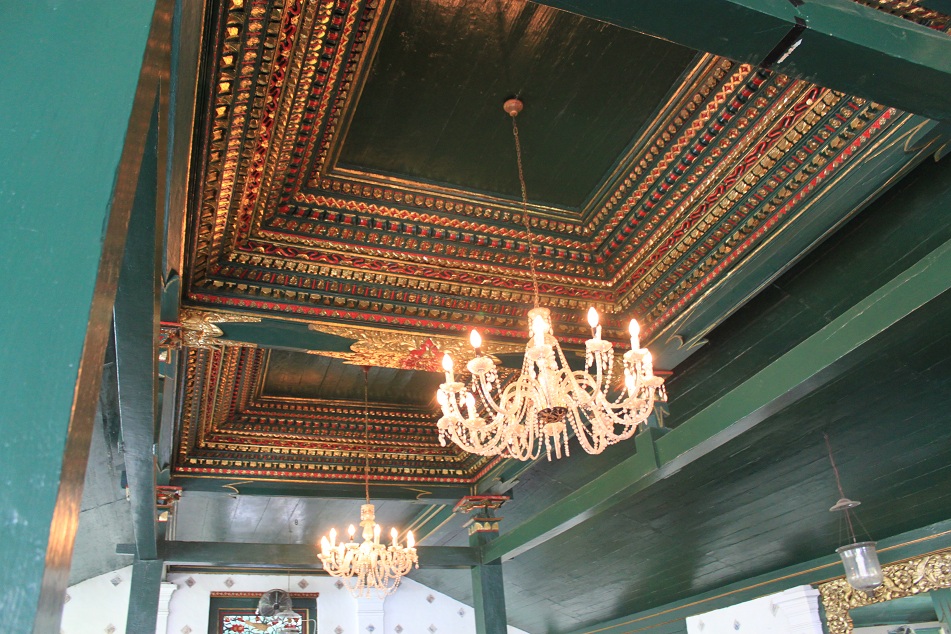
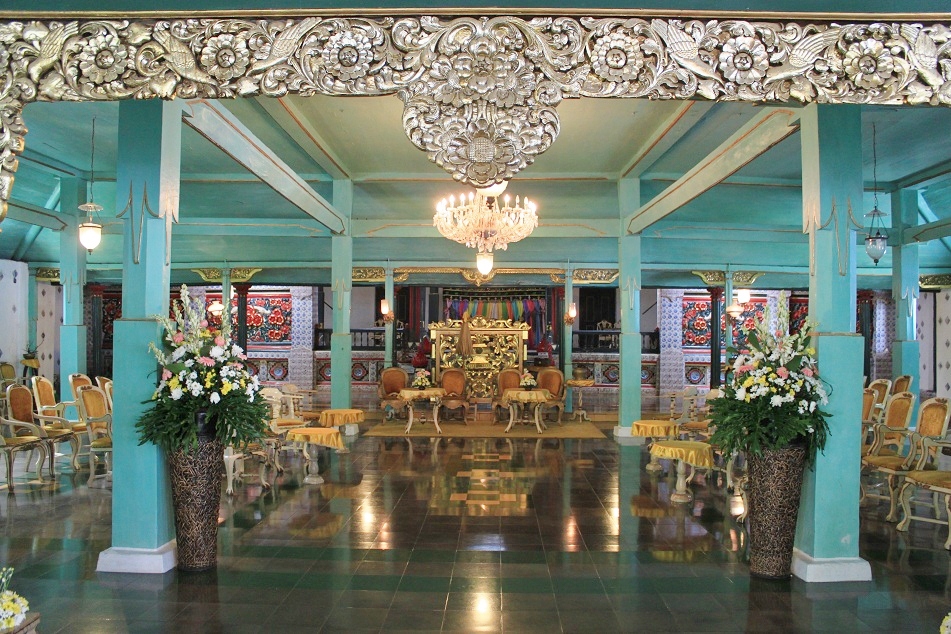
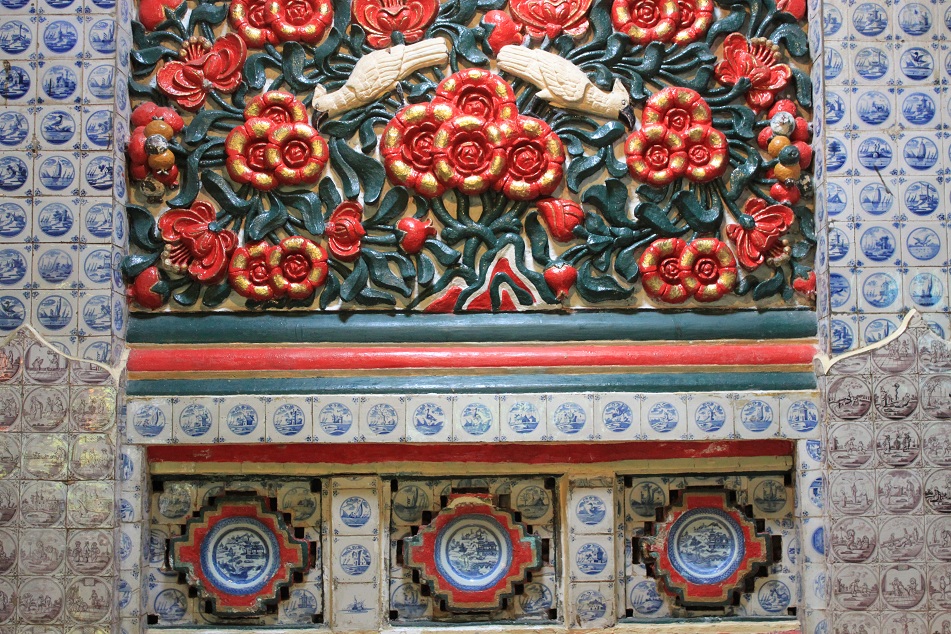
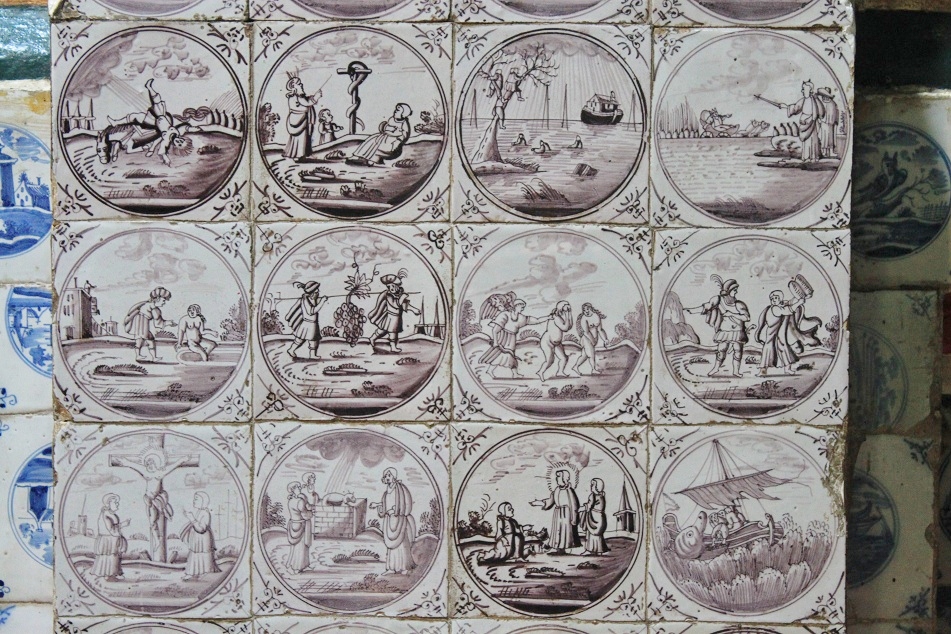

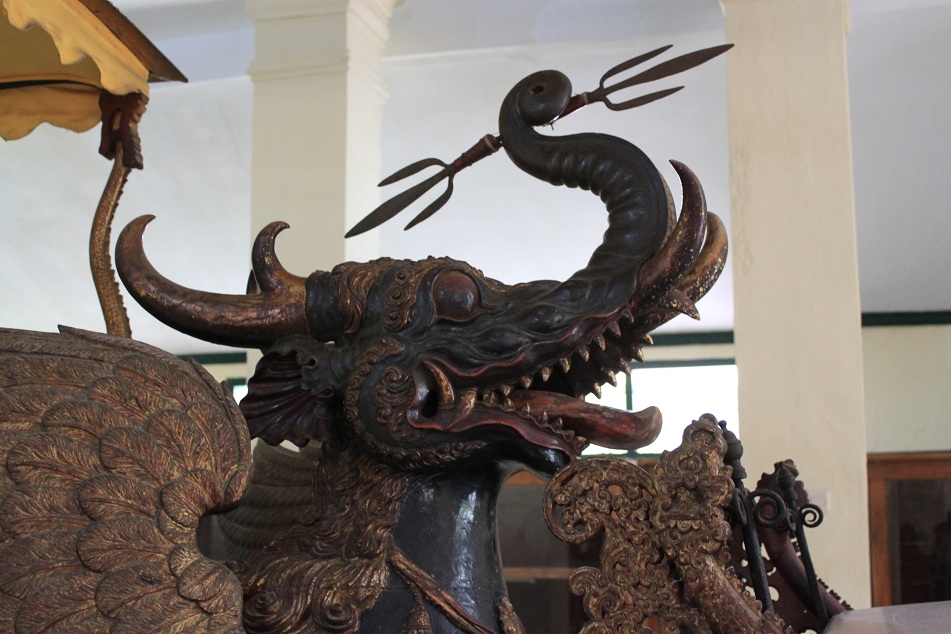
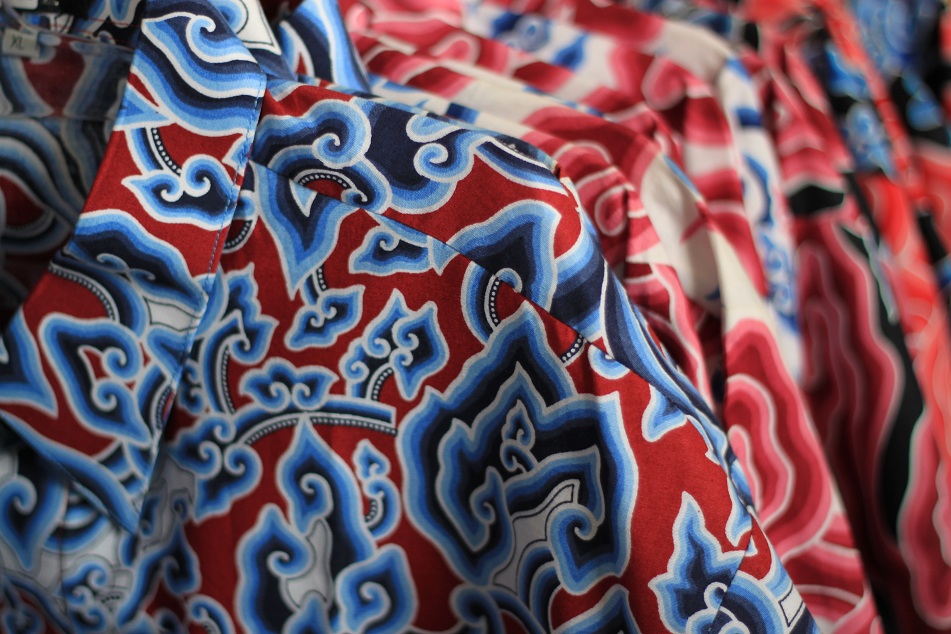
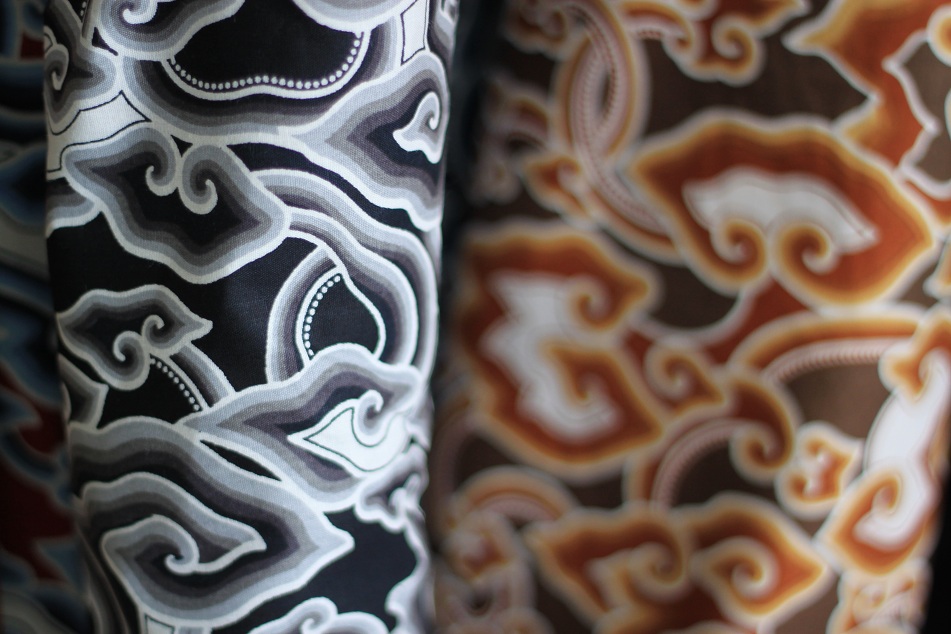
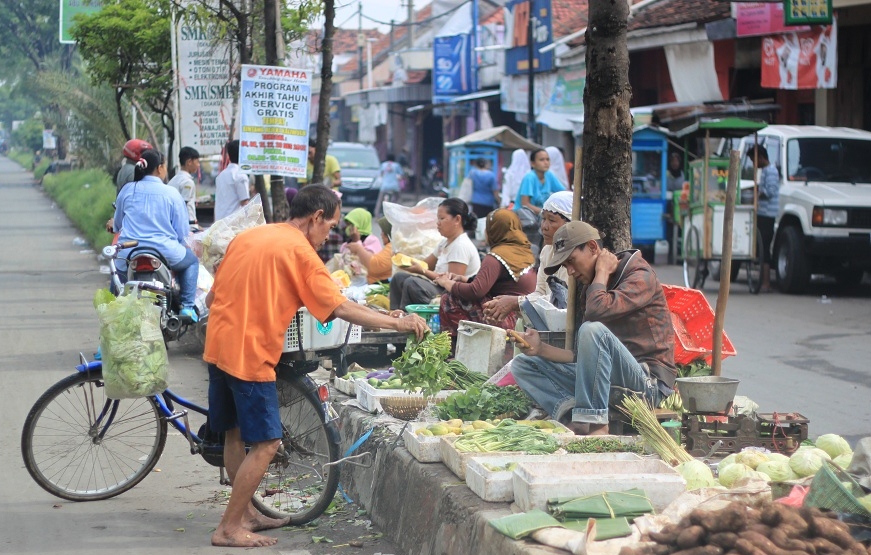
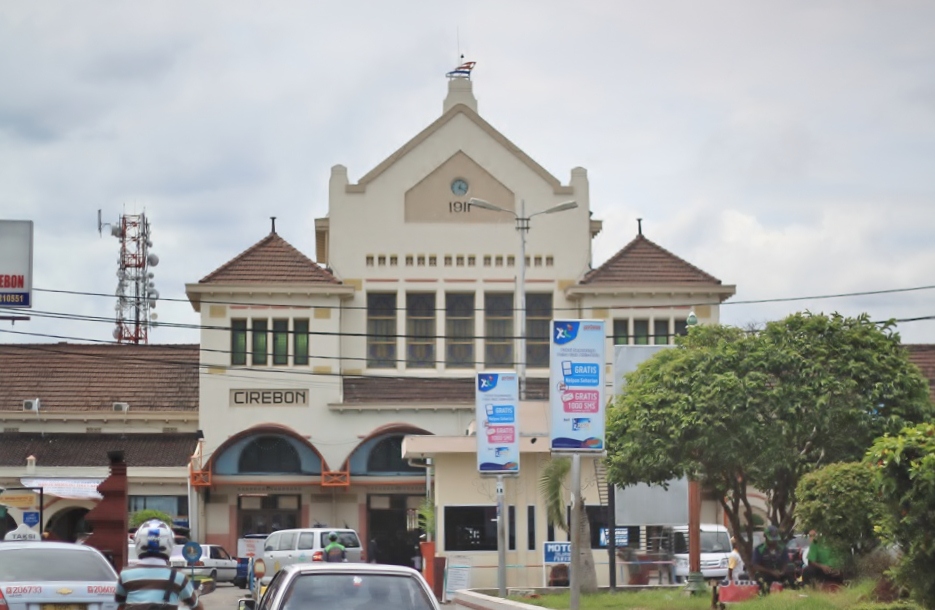
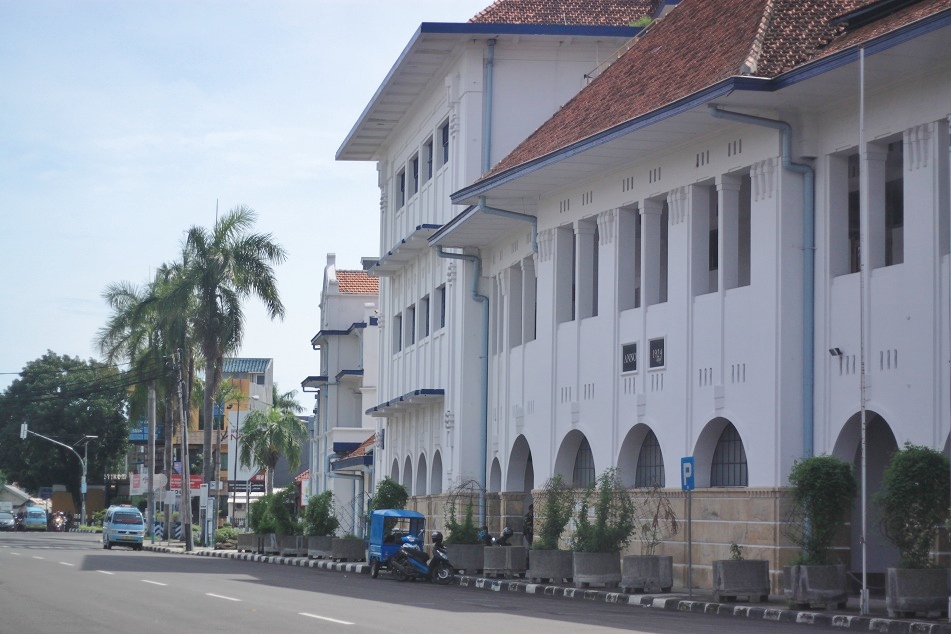
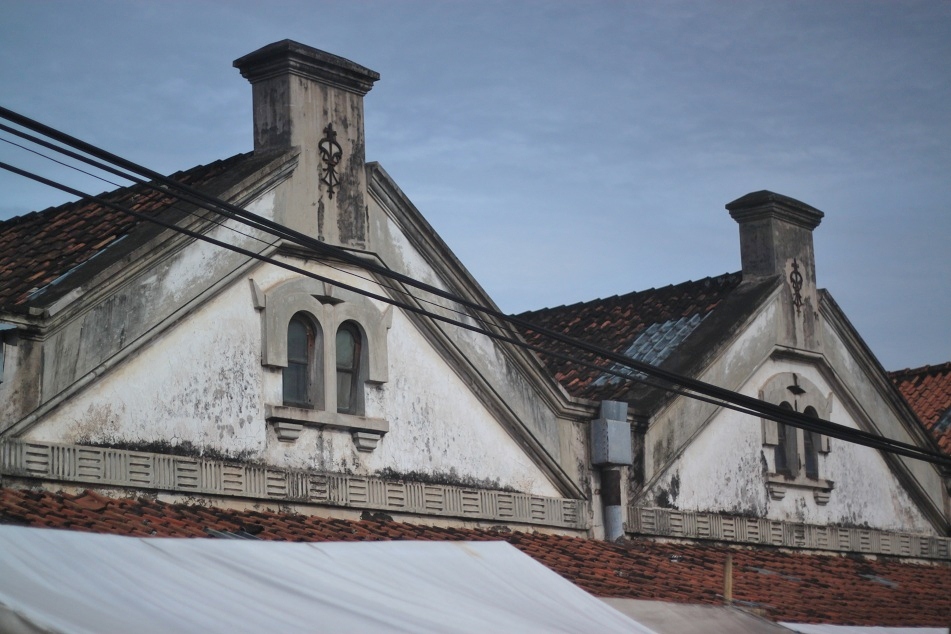
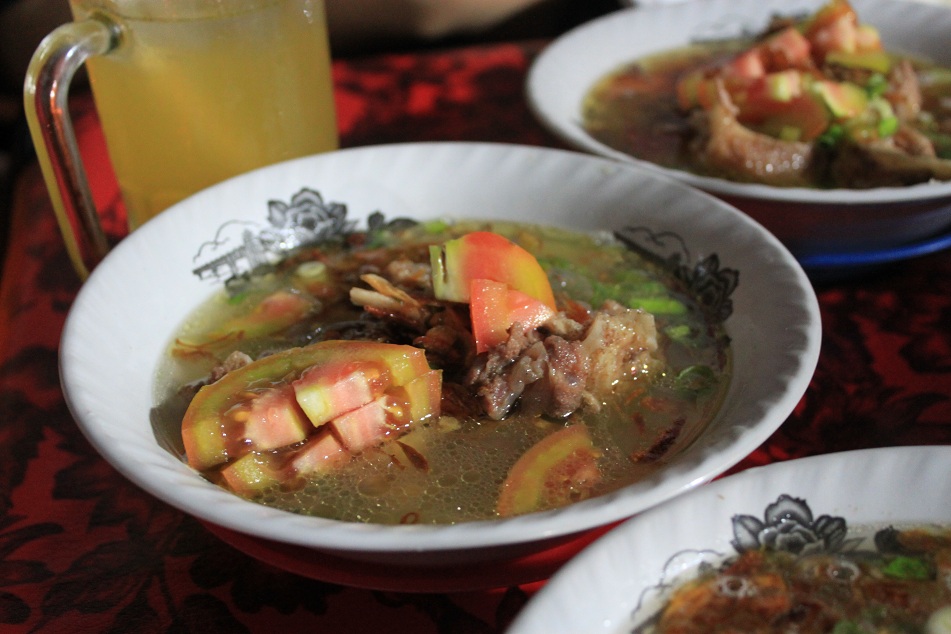
Wonderful post Bama – I especially love the mega mendung patterns, you can truly see the Chinese influence in the way those clouds are drawn! The Keraton Kasepuhan looks like such a cosy place to live… it seems beautifully decorated but not overwhelmingly so. 🙂
LikeLike
Thanks James! Compared to other Batik patterns, mega mendung looks fresh and modern. The Keraton actually looks more like a large old house of a wealthy Indonesian. In fact, many modern houses are more swanky than the Keraton. 🙂
LikeLike
Thanks for taking me Bama. Sad to say I’ve not seen much of beautiful Indonesia, so this was a special treat. And breakfast looks perfect 🙂
LikeLike
You’re welcome Meredith! Indonesia and Sri Lanka are not that far away, and it’s even closer to Australia. So you’ll never know, maybe it will be sooner than later that you’ll find yourself in Indonesia. 🙂
LikeLike
I’m so pleased to have found your great blog and I’m now following you. Fabulous photos and interesting post about Cirebon. Thanks, Lottie
LikeLike
Thanks Lottie! Glad to know another blogger who’s based out of Jakarta. I hope today’s flooding in all over the city doesn’t affect you.
LikeLike
Great post Bam! Love the pictures. Each city in Indonesia has indeed at least one interesting place to visit, and Cirebon seems to be one of them.
LikeLike
Thanks Bin! I didn’t expect Cirebon could be this interesting actually. So you’re right – each city deserves a visit. 🙂
LikeLike
A great heritage, Bama.
LikeLike
It is indeed, Bente. I hope it can be preserved for generations.
LikeLike
A terrific post! Thank you so much for sharing this special trip. The fabrics are gorgeous:-)
LikeLike
Thanks Jeanette! My pleasure to share some of the most interesting things about this city.
LikeLike
Thanks! I really hope to visit Cirebon:-)
LikeLike
Note to self: never read this blog on an empty stomach… may spontaneously die of hunger due to provocative food descriptions.
😉 Gorgeous post, Bama. I may be betraying my own ignorance here, but I had no idea there were still sultans today. Learned something new, as always here!
LikeLike
Oops, sorry for that! 😛 Writing provocative food descriptions might have become my new habit because by doing so I can relive the moment the food entered my mouth – more often than not makes me think that I’m in food heaven! Thanks Meghan! I will be embarking on a 9-day trip to Istanbul next Monday. I wonder what scrumptious Turkish food I can write about when I have returned to Jakarta. 😉
LikeLike
Your food descriptions would make anyone hungry! What is the white stone that the lions are made of? Thanks for a very interesting article.
LikeLike
I hope it’s in a good way, Marilyn! 🙂 Actually I’m not sure what they’re made of but the texture seems like mortar. Thanks for reading!
LikeLike
Thanks for following my blog. We are in opposite sides of the world…very different yet similar in ways.
LikeLike
My pleasure Marilyn! I’ve never been to the western hemisphere, so for the moment on I can live vicariously through your blog.
LikeLike
Bama, so wonderful post..Came to know lot of new things and some lovely photos. Thank you so much.
LikeLike
Thanks Harish! It’s my pleasure to share some interesting stories of places that I’ve been to. 🙂
LikeLike
Beautiful photos, and the food! I would love to try it. I love the mega mendung pattern so much I had part of a jacket made and lined with it. Thanks for this post.
LikeLike
Thanks Lydia! Well, you know how addictive Indonesian food can be. 😉 Oh I have to admit that I don’t have anything with mega mendung pattern – most of the Batiks I have are in Jogja patterns. Maybe when I return to Cirebon one day I will buy some. Thanks for reading!
LikeLike
Reblogged this on Blog By Danni Kaplan and commented:
I really love other people’s adventures
LikeLike
Reblogged this on my small boutique.
LikeLike
Hi Bama, love how you captured every little details of the palace. I’d love to have one of those beautiful batik patterns!
LikeLike
Thanks Marisol! It’s a small palace but when I looked closely I found those interesting small things inside the palace.
LikeLike
Chuckling at the “Dutch style British American Tobacco house” 🙂 Cirebon, seems like a delightful place. Thank you for taking us to such off beat areas of your country Bama.
LikeLike
You got it Madhu! 🙂 There are still some historical places in Cirebon that I haven’t visited. I hope I can go back one day I can write some stories of them. You’re very welcome Madhu!
LikeLike
What a beautiful find! Loved going through your blog and this post ….beautiful. I have breifly been to Indonesia on work, just in and around Jakarta and didnt get to savor the flavor of the land. I am a travel and socio-cultural history enthusiast myself. will be following you from now
🙂
LikeLike
That would be a good reason for you to go back to Indonesia one day. 🙂 Thanks for dropping by and following my blog!
LikeLike
Waaah pas banget ada rencana mau ke Cirebon, thank you for the wonderful suggestions in your post, will be sure to check it out when I go next week.
LikeLike
Senang jika post ini membantu. Have a wonderful trip! 🙂
LikeLike
Nice post, from the picture, I agree that the audience hall looks too humble for a palace 🙂 Do you think that this is because of the humility of Sultanate of Cirebon?
LikeLike
Thanks Ethenia! I think most of Indonesian palaces have rather modest audience halls, which is not surprising at all considering how humble Majapahit’s heritages are, despite its significance. I think it runs in Indonesians’ blood. 🙂
LikeLike
bama, I like your post. you call more tourist to visit Indonesia from your photo.
LikeLike
Makasih Annisa! My intention was to share more about the diversity within the country. But it’s a nice thing to know that my posts have an even further impact. 🙂
LikeLike
hmm, asik euy jalan2 wae.. ajak2 atuh, mun ka cerbon mah ku saya we di guide na, gratis..
tasik kapan jadi tujuan wisata?
LikeLike
Oh ayeuna di Cirebon? Urang geus lila tara ka Tasik euy. Tapi hayang sih jalan-jalan nostalgia kitu. 🙂
LikeLike
Stupendous images with interesting descriptions…keep on! it’s a blessing to find out some of your travels to some corners of this world especially to some places of our country, Indonesia through the photos and their description. What about traveling to some exotic places in the eastern part of Indonesia, e.g. Toraja, South Sulawesi or Nusa Tenggara (Komodo Island)? My hometown is Labuan Bajo (but I am staying in Manila right now), the launching point for tourists going to Komodo Island.
LikeLike
Thanks Richar! Actually a year ago I have booked my flights to Makassar to visit Toraja. But then for one reason I had to cancel it. I’ve also been dreaming to go to Komodo Island, and hopefully within a few years’ time you’ll find me writing stories from those places. 🙂
LikeLike
Been to Cirebon three times and never got bored yet. And you should go back there and get lost in Trusmi 🙂
LikeLike
The next time I go back to Cirebon I will definitely find that empal gentong restaurant before exploring other places in the city. 🙂
LikeLike
There is a famous empal gentong and empal asam resto right before Trusmi area, the name Empal Gentong Amarta.
LikeLike
Noted. Thanks for the info. 🙂
LikeLike
Hebat… beruntung sekali jadi mas Bama ini “maknyos” heuheu…
Oh ya… gk sekalian mampir ke kota kecil sebelahnya bernama Kuningan + nyicipin masakan nya ? ^^
LikeLike
Hebat… beruntung sekali jadi mas Bama ini… “maknyos” heuheu…
Oh ya… gk sekalian mampir ke kota kecil sebelahnya bernama Kuningan + nyicipin masakan nya ? ^^
LikeLike
Waduh, yang hebat itu kayak Bondan Winarno, Simon Reeve, dll. Saya biasa-biasa aja kok. 🙂
Kalo ada kesempatan saya juga pengen mampir ke Kuningan sih. Makanan khas Kuningan itu apa aja ya mbak?
LikeLike